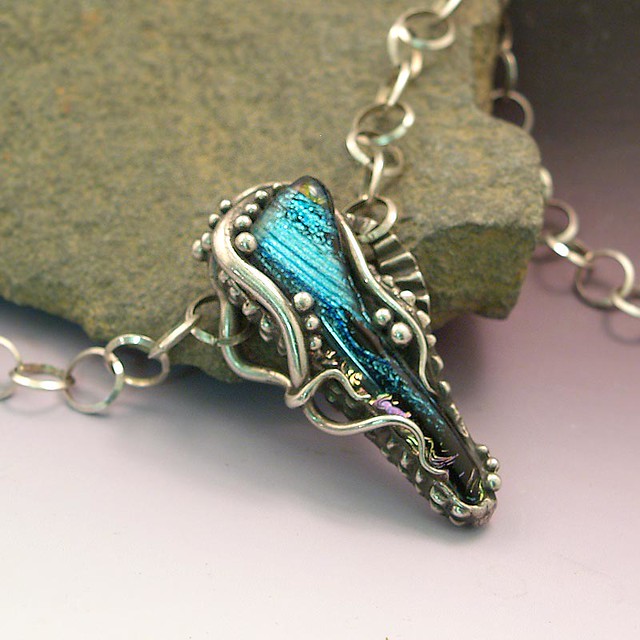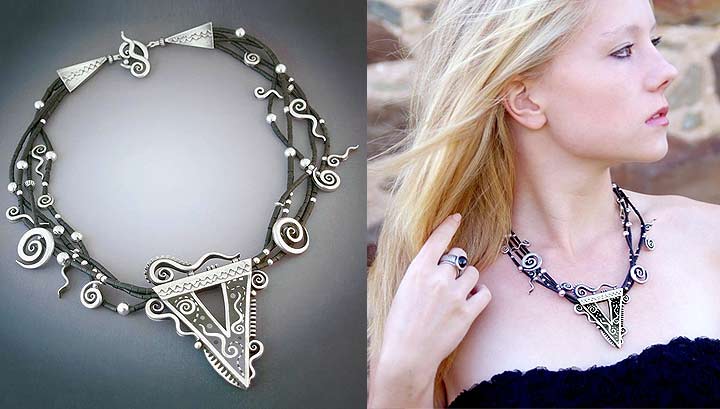Charles,
Just curious, from what you've reads and gauging people's opinion,
what did you determine?
Here’s hoping I don’t get folks wound up all over again.
The following observations are aesthetic judgments on my part. No
one has to care what my aesthetic values are. No one wins points if I
agree with them and no one should be offended if I don’t like what
they like. But you asked what I learned from the discussion, so here
goes.
One of the reasons I wasn’t liking the pmc jewelry I saw in the
jewelry magazines was that it’s coloration was often “off” from fine
or sterling silver. I learned that pmc silver jewelry didn’t have to
look like that. It could be polished to look like what it is, silver.
Another was the way the material curved in multiple dimensions
differently than sheet silver would do when hammered. It’s a subtle
thing at times, but at the subconscious level, it bothered me. The
discussion helped me to realize this was one of the things that felt
“off” about the material. The ability to do something different is a
plus - if that’s what is intended by the artist.
I already admired the ease with which the pmc could be textured. But
often times the layered pieces didn’t seem to fit together right.
(See point above, to which I think this is related.) I saw examples
where the layers fit together spot on, so the lack of a proper fit
isn’t a limitation of the material (such as something caused by the
shrinkage).
A goodly number of the pmc pieces I’ve seen in the magazines simply
didn’t look properly finished. Partly this is because the pmc pieces
often didn’t have clear, crisp lines defining their shape. I do
pottery also and a lot of the pmc work I had seen looked like badly
done hand-built pottery. It’s not a limitation of the material,
that’s a limitation of the artists whose work I had seen before I
asked my question.
In other words, it’s possible to make pieces that exhibit the
stylistic qualities I’m looking for in the jewelry I’m trying to
learn how to make.
I’ve done hand-built pottery applique decoration before and working
in pmc appears to have some similarities to that. It’s not something
I enjoy as much as the traditional metal working techniques. That’s a
“what makes David happier” judgment, which is 100% right for me and
totally worthless to anyone else.
I’ve learned that the wrong people are writing how-to articles about
using PMC - at least based on the relative quality of the work I’ve
seen on magazine covers versus the work people pointed me to. Those
of you who are really good at this, please get to work writing how-to
articles! The PMC community has a group that has put together a PMC
masters program that looks like it would help people master their
skills and turn out much higher quality work. If anyone actually
cares about that, I’ll dig up the url and post it.
I have a pre-existing strong interest in learning the ancient and
medieval jewelry making skills. Obviously, PMC does not fit in that
list.
I have a lot of skills to learn before I know exactly what and how I
want to make the items I hope to be designing and building.
I’ve added PMC to my list of things to learn how to do, but it’s
near the bottom of my personal list.
I wouldn’t give anyone any guff about putting PMC at the top of
their list of skills to learn.
If I hadn’t already invested in a burnout kiln, enameling kiln,
vacuum table, hammers, saws, chasing/repousse tools, etc., I might
put PMC at the top of my list simply because of the much smaller
start up cost.
I hope that was useful to someone - other than fueling another flame
war.



